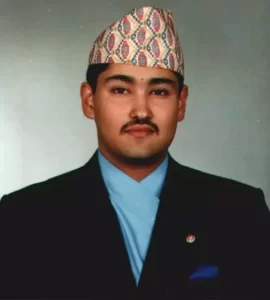King Prithivi Narayan Shah’s Biography

Prithvi Narayan Shah was the eldest son of King Narbhupal Shah and his second wife Kaushalyavati Devi. Born on Poush 27, 1779 B.S in a royal family of Gorkha, the young prince had court Upadhyaya Priests appointed to look after his studies. But it was his stepmother Chandraprahabati who taught him to be an efficient ruler. Under her care, young Prithvi Narayan Shah studied scriptures like Mahabharat and Ramayana as well as diplomatic tactics. From an early age, he was exposed to weapons, horse riding and warfare lessons. Overall, he took a great interest in state affairs. He became the king of Gorkha at age 20 after his father’s death.
Immediately after ascending the throne, he attacked Nuwakot. Nuwakot was previously contested by his father but eventually lost to the Malla kings of Kathmandu valley. Like his father, he too failed in his first attempt over Nuwakot. But the optimistic side of the defeat was that it led PN Shah to improve his army condition. Before attacking Nuwakot again, he went to Banaras to buy weapons and ammunition. Now the second attack over Nuwakot was equipped with strategic planning and improved militants that were recruited on the basis of their fitness and strength. Prior to this, only the selected caste was eligible to join the Gorkhali army. This conquest with the improvised policy was bound to be a success and the annexation of other fragmented kingdoms also began.
The attempts to control Kathmandu valley also continued. Kathmandu(Kantipur), Patan(Lalitpur), and Bhaktapur(Bhadgaon), collectively Kathmandu or Nepal valley were the prosperous kingdoms ruled by the Malla kings. For the entrance to the valley control over Kirtipur was necessary as it acted as a wall for the outsiders. The first attack in 1814 AD to Kirtipur was of great loss, as they had to lose their trusted commander in chief Kalu Pande while Prithvi Narayan Shah narrowly escaped death. They faced the same result in their second attempt. It was in 1824 AD, during his third attempt he finally conquered Kirtipur. And in the following year, he was successful in invading Patan and Lalitpur. Now, the remaining kingdom was Bhaktapur, the state of his ‘mit-ba’ Ranajit Malla. With the surrender of the King of Bhaktapur in 1826 AD, unified Nepal was established with Kathmandu appointed as the capital.
The visit to Varanasi must have played an important role when it comes to the unification campaign of PN Shah. When Shah went to Vanaras to improve his military, he had seen the power struggles of the Marathi, and Mughal kingdoms, and the British East India Company. He must have come to realize the threat posed by a foreign power to his as well as his fellow kingdoms that are fragmented and always in a warring state. So, presumably, to protect the sovereignty of greater Nepal, he started the campaign and till the end of his life stood on his belief. Even if he was asked by the courtiers and relatives for a separate state, he was against the separation. His strong desire for a unified Nepal can be seen in the instructions/teachings provided by him to his advisors, successors, and kins on his deathbed which is now called dibya upadesh.
The king who had been ill for some period of time took his last breath in Devighat, on the bank of Trishuli river on 1st Magh 1831 B.S at the age of 52.



